
|
PLACES TO GO GO |
St.
George's Cathedral 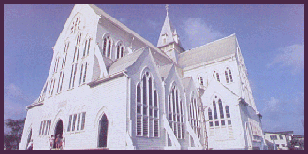 |
Designed by Sir Arthur Bloomfield and built in the
1890s, St. George's Cathedral is reputed to be one of the world's tallest wooden
buildings. Its spire rises over 132 feet. The Chief Church of the Anglican Diocese is
found in the heart of George- town. The story of the Cathedral is told in the interior on
tablets and memorials. It is a tale of Guyana in general and the diocese in particular. |
Georgetown
![[An aerial View of Georgetown]](gtown01.jpg) |
Georgetown, the capital city has an estimated
population of 183,000 and is situated at the mouth of the Demerara River on its eastern
bank. It is often described as the "GARDEN CITY OF THE CARIBBEAN". The
city is below the high water mark of the spring tides of the Atlantic Coast. The ocean is
kept out by a massive wall forming a breezy esplanade on the sea front and by river and
wharf walls on the river front. The streets of the city are laid out at right angles to
each other. The checker board layout of the city is a heritage from its Dutch past. The
town which eventually grew into Georgetown, was first named Stabroek by the Dutch and
several Dutch names are still in use. Today, it is a picturesque city with broad tree
lined avenues and many noble buildings including some handsome wooden dwelling houses of
architectural interest and the conical Amerindian Benab - the Umana Yana. |
Stabroek Market
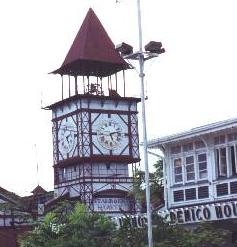 |
The main market on Water Street, Georgetown,
administered by the City Council, is built entirely of cast iron and extends into the
Demerara River. Opened to the public since 1881, it lives up to its reputation of having
anything, from a pin to an anchor for sale. |
|
|
|
| Umana Yana This conical palm thatched
structure erected for the Non-Aligned Foreign Ministers Conference in August 1972 as a
V.I.P. Lounge and recreation center, is now a permanent and much admired part of
Georgetown's scenery. The structure is 55 feet high and was erected by a team of Wai Wai
Amerindians, one of the nine indigenous tribes of Guyana. Fashioned like the Wai Wai
benabs or shelters which are found deep in Guyana's interior, it occupies an area of 460
square meters. Umana Yana is an Amerindian word meaning "Meeting place of the
people". Liberation Monument On the grounds of the Umana Yana
rises a memorial of five timber columns standing behind a granite boulder and surrounded
by a jasper pavement. The memorial was consecrated to the Struggle for Freedom everywhere,
on the occasion of the visit of the Council of Namibia to Guyana in August l974. The
following words are engraved on the granite boulder:
"Mourn not for us who died But
for our brothers everywhere Who live in bondage And mourning, turn away to
act". The Non-Aligned Monument at Company Path In l907 the entrance to
the old Anglican Cathedral, together with the entire width of Company Path, was handed
over by the Government to the Mayor and Town Council. In 1908 part of the land was
enclosed by an iron rail and planted as a Garden - the Company Path Garden. During the
Conference of Foreign Ministers of Non-Aligned countries held in Guyana from August 8-11,
1972, a monument to the four founders of the Non-Aligned Movement - President Nasser of
Egypt, President Kwame Nkrumah of Ghana, Jawaharlal Nehru of India and President Tito of
Yugoslavia - was erected in this garden and was unveiled by the then President, Arthur
Chung. Since then, most Heads of State visiting Guyana have taken the opportunity to pay
tribute to these great statesmen of the Non-Alignment Movement by laying floral tributes
at the Monument, the only one of its kind in the Non-Aligned world |
The
Botanic Gardens
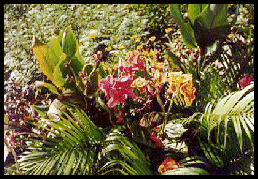 |
The Botanic Gardens is one
of Georgetown's popular recreation parks. In 1877, Government voted $72,000 to establish
the Gardens, and John Frederick Waby, the first gardener, arrived in Georgetown in
December 1878. He spent 35 years in Guyana landscaping one of the finest tropical gardens
in our region. These gardens have a huge variety of tropical flowers and one of the finest
collection of palms, as well as lovely lilies. An example of the gardens vast collection
are the lotus and the immense Victoria Regia Lily, Guyana's national flower, which was
first discovered in the Berbice River. |
|
|
|
|
Kaieteur Falls
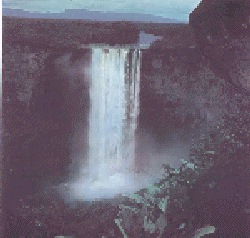 |
The Kaieteur Falls, which was discovered on the 29
April 1870 by Charles Barrington Brown, the famous hinterland explorer, is situated on the
Potaro River, a tributary of the Essequibo River. The waters of Kaieteur, one of the
natural wonders of the world, flow over a sandstone table and land into a deep valley - a
drop of 741 feet or five times the height of Niagara. Kaieteur takes the form of a huge
perpendicular column of water which cascades into a rainbowed gorge only to be transformed
into a mountain of foam with a "billion eyes that hypnotize". There are no other
falls in the world with the magnitude of the sheer drop existing at Kaieteur. The width of
the Fall varies from 250 feet in the dry season to 400 feet at the height of the wet
season. Amerindian legend of the Patamona tribe has it that Kaie, one of the tribe's great
old Chieftains, after whom Kaieteur is named, committed self-sacrifice by canoeing himself
over the falls in order that Makonaima, the great spirit, would save the tribe from being
destroyed by the savage Caribisi. |
Timehri International Airport
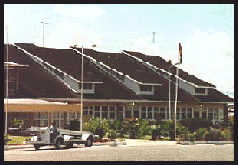 |
Timehri International Airport is on the right bank
of the Demerara River, 26 miles south of Georgetown, the capital. The word Timehri
literally means "Rock Painting" and is the name given to the rock paintings or
engravings found in the interior of Guyana, particularly near falls and rapids. Legend has
it that the Timehri art was the work of the Amerindian folklore god
"Amalivacar", who visited Guyana at the time of the flood. Anthropologists,
however, consider that the paintings date back to the 14th century. A mural done in the
Timehri Motif by famous Guyanese artist, the late Aubrey Williams, adorns the outer wall
of the airport's V.I.P. Lounge. |
|
|
|
 |
|
 GO
GO
![[An aerial View of Georgetown]](gtown01.jpg)



